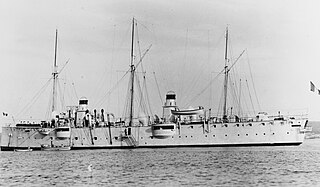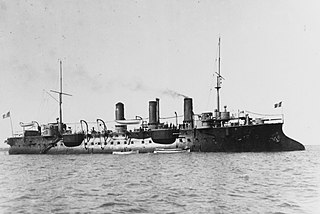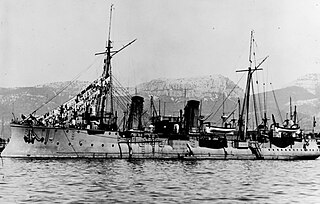
Châteaurenault was a large protected cruiser built for the French Navy in the late 1890s and early 1900s. She was intended to serve as a long-range commerce raider, designed according to the theories of the Jeune École, which favored a strategy of attacking Britain's extensive merchant shipping network instead of engaging in an expensive naval arms race with the Royal Navy. As such, Châteaurenault was built with a relatively light armament of just eight medium-caliber guns, but was given a long cruising range and the appearance of a large passenger liner, which would help her to evade detection while raiding merchant shipping.

Jurien de la Gravière was a protected cruiser built for the French Navy in the late 1890s and early 1900s, the last vessel of that type built in France. Intended to serve overseas in the French colonial empire, the ship was ordered during a period of internal conflict between proponents of different types of cruisers. She was given a high top speed to enable her to operate as a commerce raider, but the required hull shape made her maneuver poorly. The ship also suffered from problems with her propulsion machinery that kept her from reaching her intended top speed. She carried a main battery of eight 164 mm (6.5 in) guns and was protected by a curved armor deck that was 35–65 mm (1.4–2.6 in) thick.

The D'Estrées class comprised two protected cruisers of the French Navy built in the late 1890s. The two ships were D'Estrées and Infernet, though a third was projected but was canceled before work began. They were ordered during a period of intense debate in the French fleet between officers who favored large armored cruisers and those who preferred smaller vessels more suited to long-distance cruising abroad. The D'Estrées-class cruisers were intended to operate in the French colonial empire. The ships were armed with a main battery of two 138 mm (5.4 in) guns supported by four 100 mm (3.9 in) guns and they had a top speed of 20 to 20.5 knots.

Troude was a protected cruiser of the French Navy, the lead ship of the Troude class. The class was built as part of a construction program intended to provide scouts for the main battle fleet. They were based on the preceding Forbin class, the primary improvement being the addition of armor to the conning tower. Troude was built in the 1880s and was completed in late 1890. She was armed with a main battery of four 138 mm (5.4 in) guns, protected with an armor deck that was 41 mm (1.6 in) thick, and had a top speed of 20.5 knots.

Guichen was a large protected cruiser built in the 1890s for the French Navy, the only member of her class. She was intended to serve as a long-range commerce raider, designed according to the theories of the Jeune École, which favored a strategy of attacking Britain's extensive merchant shipping network instead of engaging in an expensive naval arms race with the Royal Navy. As such, Guichen was built with a relatively light armament of just eight medium-caliber guns, but was given a long cruising range and the appearance of a large passenger liner, which would help her to evade detection while raiding merchant shipping.

D'Entrecasteaux was a large protected cruiser built for the French Navy in the 1890s. The only vessel of her class, D'Entrecasteaux was intended to serve as a flagship of the cruiser squadron that defended French Indochina and other possessions in the Far East. Her construction came during a period of conflict in the French naval command between factions that favored different cruiser types; D'Entrecasteaux represented the ideas of the Jeune École, who favored large cruisers for long-range operations overseas. She was armed with a main battery of two 240 mm (9.4 in) guns, the largest guns ever carried aboard a French cruiser, though their great weight, coupled with her pronounced ram bow degraded her seaworthiness. She nevertheless provided the basis for later armored cruisers.

The Descartes class comprised two protected cruisers of the French Navy built in the early 1890s; the two ships were Descartes and Pascal. They were ordered as part of a naval construction program directed at France's rivals, Italy and Germany, particularly after Italy made progress in modernizing its own fleet. The plan was also intended to remedy a deficiency in cruisers that had been revealed during training exercises in the 1880s. As such, the Descartes-class cruisers were intended to operate as fleet scouts and in the French colonial empire. The ships were armed with a main battery of four 164.7 mm (6.48 in) guns supported by ten 100 mm (3.9 in) guns and they had a top speed of 19 knots.

Forbin was a protected cruiser, the lead ship of the Forbin class, built in the late 1880s for the French Navy. The class was built as part of a construction program intended to provide scouts for the main battle fleet. They were based on the earlier unprotected cruiser Milan, with the addition of an armor deck to improve their usefulness in battle. They had a high top speed for the time, at around 20 knots, and they carried a main battery of four 138 mm (5.4 in) guns.

Linois was the lead ship of her class of protected cruisers built for the French Navy in the 1890s. The class was ordered as part of a construction program directed at strengthening the fleet's cruiser force. At the time, France was concerned with the growing naval threat of the Italian and German fleets, and the new cruisers were intended to serve with the main fleet, and overseas in the French colonial empire. Linois was armed with a main battery of four 138.6 mm (5.5 in) guns, was protected by an armored deck 40 mm (1.6 in) thick, and had a top speed of 20.5 knots.

Isly was a Jean Bart-class protected cruiser built in the late 1880s and early 1890s for the French Navy. The second and final member of the class, Isly and her sister ship were ordered during the tenure of Admiral Théophile Aube as Minister of Marine according to the theories of the Jeune École doctrine. The ships were intended as long-range commerce raiders, and they were armed with a main battery of four 164 mm (6.5 in) guns, were protected by an armor deck that was 50 to 100 mm thick, and were capable of steaming at a top speed of around 19 knots.

Friant was a protected cruiser of the French Navy built in the 1890s, and the lead ship of the Friant class. Friant and her two sister ships were ordered as part of a major construction program directed against France's Italian and German opponents in the Triple Alliance, and they were intended to serve with the main fleet, and overseas in the French colonial empire. They were armed with a main battery of six 164 mm (6.5 in) guns and had a top speed of 18.7 knots.

Bugeaud was a Friant-class protected cruiser of the French Navy built in the 1890s, the second of three ships of the class. The Friant-class cruisers were ordered as part of a construction program directed at strengthening the fleet's cruiser force. At the time, France was concerned with the growing naval threat of the Italian and German fleets, and the new cruisers were intended to serve with the main fleet, and overseas in the French colonial empire. Bugeaud and her two sister ships were armed with a main battery of six 164 mm (6.5 in) guns, were protected by an armor deck that was 30 to 80 mm thick, and were capable of steaming at a top speed of 18.7 knots.

Descartes was the lead ship of the Descartes class of protected cruisers built for the French Navy in the 1890s. The Descartes-class cruisers were ordered as part of a construction program directed at strengthening the fleet's cruiser force. At the time, France was concerned with the growing naval threat of the Italian and German fleets, and the new cruisers were intended to serve with the main fleet, and overseas in the French colonial empire. Descartes was armed with a main battery of four 164.7 mm (6.5 in) guns, was protected by an armor deck that was 20 to 40 mm thick, and was capable of steaming at a top speed of 19 knots.

Cassard was a D'Assas-class protected cruiser built for the French Navy in the 1890s. The D'Assas-class cruisers were ordered as part of a construction program directed at strengthening the fleet's cruiser force at a time the country was concerned with the growing naval threat of the Italian and German fleets. The new cruisers were intended to serve with the main fleet and overseas in the French colonial empire. Cassard was armed with a main battery of six 164 mm (6.5 in) guns, was protected by an armor deck that was 70 to 80 mm thick, and was capable of steaming at a top speed of 20 knots.

Catinat was the lead ship of the Catinat class of protected cruisers built for the French Navy in the 1890s. The Catinat-class cruisers were ordered as part of a construction program directed at strengthening the fleet's cruiser force at a time the country was concerned with the growing naval threat of the Italian and German fleets. The new cruisers were intended to serve with the main fleet and overseas in the French colonial empire. Catinat was armed with a main battery of four 164 mm (6.5 in) guns, was protected by an armor deck that was 25 to 60 mm thick, and was capable of steaming at a top speed of up to 20 knots.

Protet was a protected cruiser of the French Navy built in the 1890s, the second and final member of the Catinat class. The Catinat-class cruisers were ordered as part of a construction program directed at strengthening the fleet's cruiser force at a time when the country was concerned with the growing naval threat of the Italian and German fleets. The new cruisers were intended to serve with the main fleet and overseas in the French colonial empire. Protet was armed with a main battery of four 164 mm (6.5 in) guns, was protected by an armor deck that was 25 to 60 mm thick, and was capable of steaming at a top speed of up to 20 knots.

Infernet was the second and final member of the D'Estrées class of protected cruisers built for the French Navy in the 1890s. The D'Estrées-class cruisers were ordered as part of a construction program directed at strengthening the fleet's cruiser force at a time the country was concerned with the growing naval threat of the Italian and German fleets. The new cruisers were intended to serve overseas in the French colonial empire. D'Estrées was armed with a main battery of two 138 mm (5.4 in) guns, was protected by an armor deck that was 38 to 43 mm thick, and was capable of steaming at a top speed of up to 20 to 20.5 knots.

Cassini was the second member of the D'Iberville class of torpedo cruisers built for the French Navy in the 1890s. The class is also sometimes classified as torpedo gunboats or torpedo avisos. The D'Iberville-class ships were a development of earlier torpedo cruisers, with the chief improvement being a significantly higher speed. Cassini was armed with three 450 mm (17.7 in) torpedo tubes and a single 100 mm (3.9 in) gun as her primary offensive armament.

Casabianca was the third and final member of the D'Iberville class of torpedo cruisers built for the French Navy in the 1890s. The class is also sometimes classified as torpedo gunboats or torpedo avisos. The D'Iberville-class ships were a development of earlier torpedo cruisers, with the chief improvement being a significantly higher speed. Casabianca was armed with three 450 mm (17.7 in) torpedo tubes and a single 100 mm (3.9 in) gun as her primary offensive armament.



















